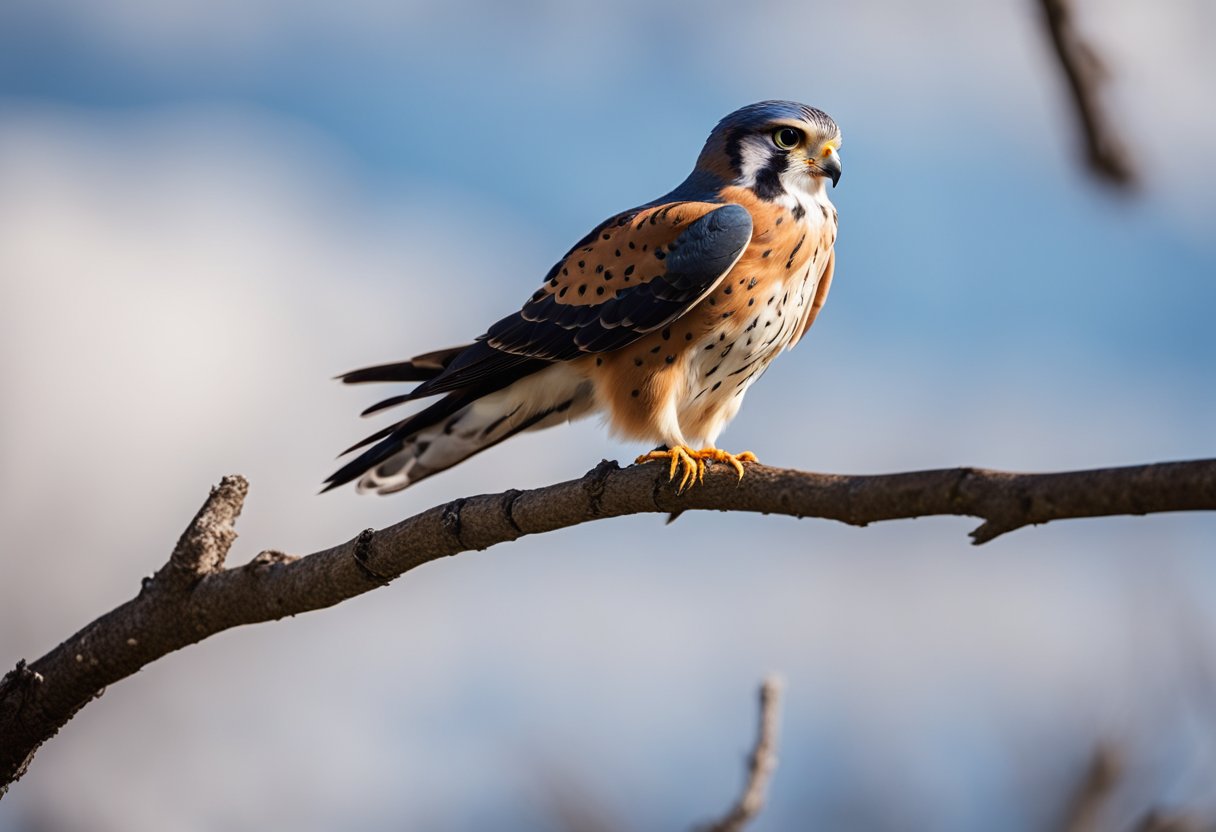Overview of the American Kestrel
The American Kestrel, scientifically known as Falco sparverius, is North America’s smallest falcon. It exhibits notable physical characteristics, occupies diverse habitats, and has a varied diet that primarily consists of small creatures.
Physical Characteristics
The American Kestrel measures about 9 to 12 inches in length, with a wingspan ranging from 20 to 24 inches. Males and females exhibit sexual dimorphism, with males displaying vibrant blue-gray wings and a rusty red back. In contrast, females possess a more subdued brown plumage with streaks. Their heads are characterized by bold facial markings, including black mustache-like stripes, enhancing their striking appearance. The tail is long and pointed, allowing for agile flight, and features black bands, particularly prominent in females.
Habitat and Range
American Kestrels thrive in diverse habitats including open fields, grasslands, and urban areas. They are found throughout North America, from the southern regions of Canada to Mexico. Their adaptability enables them to inhabit agricultural lands, where they can easily find perches for hunting. Kestrels prefer habitats with short vegetation that offers good visibility for spotting prey. They often nest in tree cavities and man-made structures, making them a common sight across various landscapes in the United States and beyond.
Diet and Prey
The diet of the American Kestrel primarily consists of insects, small mammals, and sometimes small birds. They frequently hunt grasshoppers, crickets, and beetles, employing a strategy of hovering mid-air to spot prey below. Additionally, they may capture lizards and small rodents like mice. Their hunting technique involves swift dives from a perch, utilizing sharp talons for grasping. Kestrels are essential for controlling pest populations, thus playing a vital role in their ecosystem. Their diverse diet reflects their adaptability to varying environments and availability of resources.
Behavior and Reproduction

The American Kestrel exhibits distinct behaviors during breeding and nesting, as well as sophisticated hunting tactics. These aspects are crucial for their survival and reproduction in various environments.
Breeding and Nesting
American Kestrels generally breed from March to August. Males perform courtship displays, showcasing their agility and vibrant plumage to attract females. The female selects a nesting site, often opting for tree cavities or man-made nest boxes.
Typically, they lay 3 to 7 eggs, which are incubated solely by the female for about 28 to 33 days. The eggs are white to pale cream in color, speckled with brown. After hatching, the young are altricial, reliant on their parents for food and protection.
Both parents participate in caring for the young, providing a critical support system for their development. Juveniles fledge around 30 to 35 days post-hatching, but they remain dependent on their parents for several weeks.
Hunting Tactics and Feeding
American Kestrels are skilled hunters, employing a variety of techniques. They often perch conspicuously, using their sharp eyesight to locate prey. They primarily hunt small mammals, insects, and occasionally birds.
Kestrels exhibit a unique hunting tactic known as “hovering,” allowing them to remain stationary in the air against the wind while scanning the ground. This behavior aids them in spotting prey effectively.
Once a target is identified, they dive swiftly to capture it with their talons. Their diet varies seasonally, influenced by the availability of prey.
Conservation efforts focus on providing suitable nesting sites and minimizing habitat loss. Understanding their behavior helps inform these critical conservation strategies.
Conservation Status and Efforts
The American Kestrel faces several challenges that impact its population. Conservation efforts are underway to address threats and ensure the species‘ survival through habitat protection and research initiatives.
Population Threats and Challenges
American Kestrels experience population declines due to various factors. Habitat loss from urban development, agriculture, and pesticide use reduces available nesting sites and prey. The decline in insect populations, which affects food availability, also poses a significant challenge.
In North America, kestrels are affected by competition for nesting cavities with species such as European Starlings and House Sparrows. Additionally, environmental contaminants, including lead from ammunition, have negative impacts on health and reproduction. Migration patterns may be disrupted due to climate change, requiring kestrels to adapt to new conditions.
Protection and Research
Conservation programs focused on the American Kestrel are gaining momentum. Organizations like the Cornell Lab of Ornithology conduct research to monitor kestrel populations and assess habitat needs. Building and placing artificial nest boxes helps enhance nesting success, especially in areas where natural cavities are scarce.
Collaborative efforts between governmental agencies and wildlife organizations aim to implement best practices for land use, promoting habitat preservation. Educational initiatives also raise awareness about the importance of raptors in ecosystems. Ongoing research into migration patterns and population dynamics will provide critical data to inform conservation strategies, ensuring that American Kestrels continue to thrive in their natural habitats.
Share this content:

Post Comment
You must be logged in to post a comment.